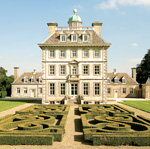Ashdown House contents sale
The contents of one of England's most beautiful Queen Anne houses are to go under the hammer at Sotheby's


Ashdown House is a stunning 17th century house near Lambourn in Berkshire which was offered for sale on a combined National Trust leasehold/freehold agreement by Knight Frank and Carter Jonas last year.
The house was built for William, 1st Earl of Craven, possibly by the Dutch-born architect Capt William Winde, in 1663. He intended it for the object of his love, Elizabeth of Bohemia, sister of King Charles I and a celebrated romantic heroine of the Stuart period. It is thought that Craven built Ashdown House for his beloved Elizabeth after hearing of her ‘longing to live in quiet', Ashdown - built on the site of a medieval deer park - would have been a most fitting refuge for the Queen who had spent many years living in forced exile at her impoverished court in The Hague. Sadly, it was not to be, as before the house was completed Elizabeth died suddenly in February 1662, while visiting her nephew King Charles II in London.
The Craven family lived in Ashdown House until its donation in 1956 by Cornelia, Countess of Craven to the National Trust, which has leased the property to select individuals since its acquisition.
Before putting it on the market, the present tenants had lived at Ashdown House since 1984, and with leading international interior designer David Mlinaric, masterminded a complete refurbishment that has returned Ashdown to its former glory, and made it one of Britain's greatest Restoration houses.
The lease of Ashdown has been sold and Sotheby's has been asked to hold a sale of the contents of the house, which will take place on October 27 in Sotheby's New Bond Street galleries.
Harry Dalmeny, Deputy Chairman, Sotheby's UK, says: 'Many great houses have stories attached, but few can tell a love story as compelling as that of Ashdown House. That story is, of course, embedded in the fabric of the building, but it is also, to a large extent, played out in portraits and furnishings that make up October's sale, each of which was sought out with a careful and sympathetic eye, and many of which - the portraits especially - not only depict the protagonists in the tale, but were also once a part of the fabric of their lives.'
Richard Henderson, General Manager for the National Trust, Oxfordshire, adds: 'Ashdown House has provided a much-loved home for its tenants, who have been extremely sympathetic to the history and beauty of the house. In recent years, the Trust has acquired additional land to create what is now a 500 acre estate which is made up of farmland and semi-ancient woodland. The house has a dolls house like appearance and is laid out over four storeys, and is constructed of locally sourced chalk blocks. The main staircase, which remains open to the public*, occupies a quarter of the house and is hung with portraits, mostly members of the Winter Queen's family.'
Sign up for the Country Life Newsletter
Exquisite houses, the beauty of Nature, and how to get the most from your life, straight to your inbox.
The sale includes portraits thought to be of Lord Craven and Elizabeth as well as furnishings such as a pair of Dutch Delft pyramid flower vases.
-
 'Monolithic, multi-layered and quite, quite magnificent. This was love at first bite': Tom Parker Bowles on his lifelong love affair with lasagne
'Monolithic, multi-layered and quite, quite magnificent. This was love at first bite': Tom Parker Bowles on his lifelong love affair with lasagneAn upwardly mobile spaghetti Bolognese, lasagne al forno, with oozing béchamel and layered meaty magnificence, is a bona fide comfort classic, declares Tom Parker Bowles.
By Tom Parker Bowles
-
 Country houses, cream teas and Baywatch: Country Life Quiz of the Day, April 24, 2025
Country houses, cream teas and Baywatch: Country Life Quiz of the Day, April 24, 2025Thursday's Quiz of the Day asks exactly how popular Baywatch became.
By Toby Keel